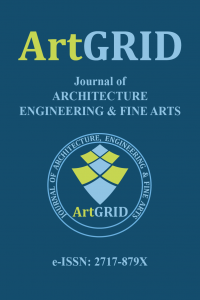BİR YAPAY ZEKÂ TEKNİĞİ OLARAK MİMARİ TASARIMDAKİ SÜRÜ ZEKÂSI
Makale, temel olarak mimari tasarımda Yapay Zekâ temelli tekniklerin gelişimi üzerine bir tartışmaya odaklanır. Tasarım problemlerinin üstesinden gelmek amacıyla esnek zekâ tekniklerinde meydana gelen güncel değişimler, çalışmanın motivasyon noktasını oluşturmaktadır. Makale, temelde yapa zekâ kavramının analitik ve matematik felsefesi yardımıyla nasıl geliştiğini tartışmayı amaçlar ve sürü zekasının mimari tasarım alanında nasıl uygulandığını araştırır. Yöntem olarak, yapay zekâ arka fikrinin arka planını göstermek için teorik bir yaklaşım kullanır. Bu sebeple, makale sürü zekâsı stratejisiyle yaratılan; Alisa Andrasek tarafından tasarlanan 'Seroussi Pavillion', Joshua M. Taron tarafından tasarlanan 'Yapısal olarak akıllı sürüler', Zaha Hadid tarafından tasarlanan 'Swarm Chandelier', Arne Quinze tarafından tasarlanan 'The Sequence', ve son olarak Tyler Julian Johnson'ın ‘Sürü Temelli Projesi’ gibi bazı mimari örneklere odaklanır. Alandaki kaynak ve çalışma azlığı bu makalenin temel kısıtlamasını yaratmıştır. Çalışma literatüre katkı olarak, mimari tasarımdaki sürü algoritmasının, mimarlar ve sanatçılar için yeni fikirler sağladığını ve tasarım sürecini destekleyerek yüksek potansiyelli bir yaklaşım olduğu göstermektedir.
Anahtar Kelimeler:
Mimari Tasarım, Esnek hesaplama, Sürü Zekâsı
SWARM INTELLIGENCE IN ARCHITECTURAL DESIGN AS A TECHNIQUE OF AI
The article focusses on a discussion about the development of Soft Computing Techniques in AI. It aims mainly to analyse the application of swarm intelligence in the field of architectural design. The article focuses on some architectural examples created through swarm intelligence strategy are 'Seroussi Pavillion' designed by Alisa Andrasek, 'Structurally intelligent swarms' designed by Joshua M. Taron, 'Swarm Chandelier' designed by Zaha Hadid, and 'The Sequence' designed by Arne Quinze, lastly Tyler Julian Johnson's Swarm-Based Project, it says the swarm algorithm in architectural design provides new ideas for the architects and artists, and it is a highly potential approach to support the design process.
Keywords:
Architectural Design, Soft Computing, Swarm Intelligence,
___
- Abdullah, A. (2013). (2013). Zaha Hadid: Form making strategies for design (Unpublished Master Thesis), Sarjana Senibina Universiti Teknologi, Malaysia.
- Baydogan, M. Ç., (2013). Tip İmar Yönetmeliğine Uygun Vaziyet Planı Üreten Bir Yapay Zeka Destek Sistemi, Unpublished PhD Thesis, Istanbul Technical University, Istanbul.
- Casey, A. (2016). Soft computing: developments, methods and applications. New York: Nova Publishers.
- Chella, A. (Ed.) (2013). Biologically inspired cognitive architectures 2012: Proceedings of the third Annual Meeting of the BICA Society. Berlin: Springer.
- Chen, Y. (2015). Swarm intelligence in architectural design (Unpublished Master Thesis), University of California, Berkeley. USA.
- Chiu, M.-L. (Ed.) (2011). Digital design: Proceedings of the 10th International Conference on Computer Aided Architectural Design Futures. Dordrecht: Springer.
- Dietterich, T. G., & Ullman, D. G. (1986). FORLOG: A logic-based architecture for design. Corvallis, Or: Oregon State Univ., Computer Science Dep.
- Hight, C. (2006). Collective intelligence in design. London: Wiley-Academy. Johnson,T.J.(2010).Swarm Intelligence. Retrieved from http://cargocollective.com/tylerjulianjohnson/Swarm-Intelligence
- Lacoere, S., Quinze, A. (2009). Arne Quinze: The Sequence. Berlijn: Die Gestalten Verlag.
- Lee, Ji-Hyun (Ed.) (2019). Computer-Aided Architectural Design: "Hello, culture": 18th International Conference, CAAD Futures 2019, Daejeon, Republic of Korea, June 26-28, 2019: selected papers.
- Müller, V. C. (2018). Philosophy and theory of artificial intelligence 2017. Cham, Switzerland: Springer.
- Seroussi, N., Guenoun, E. (2007). Pavillion Seroussi: Biothing, DORA (Design Office for Research and Architecture), EZCT Architecture & Design Research, IJP - George L. Legendre, Xefirotarch. Orléans: Editions HYX.
- Taron, J. M. (2012). Structurally intelligent swarms, ITcon Vol. 17, Special issue CAAD and innovation, pg. 283-299, https://www.itcon.org/2012/18
- Taron, J.M. (2009). Interactive Hemostasis Modeling in Urban Network Design. International Journal of Architectural Computing, 7, 3, 375-387.
- Wells, A. (2006). Rethinking cognitive computation: Turing and the science of the mind. Houndmills, Basingstoke, Hampshire, England: Palgrave Macmillan.
- Wiesenhuetter, S., Wilde, A., Noennig, J. R. (2016). Swarm intelligence in architectural design. Lecture Notes in Computer Science (including Subseries Lecture Notes in Artificial Intelligence and Lecture Notes in Bioinformatics), 3-13.
- Yayın Aralığı: Yılda 2 Sayı
- Başlangıç: 2019
- Yayıncı: Hakan OĞUZ
Sayıdaki Diğer Makaleler
YIĞMA YAPILARIN BÖLGESEL DEPREM RİSK DAĞILIMLARININ BELİRLENMESİ ÜZERİNE BİR ÇALIŞMA
Veda Seven BİÇEN, Ercan IŞIK, Enes ARKAN, Ali Emre ULU
YAPAY VASKÜLER GREFTİN İPEK FİBROİN VE KURKUMİN İLE KAPLANMASI
Merve Deniz KÖSE, Oguz BAYRAKTAR
BİR YAPAY ZEKÂ TEKNİĞİ OLARAK MİMARİ TASARIMDAKİ SÜRÜ ZEKÂSI
Hasan Basri KARTAL, Asiye Nisa KARTAL
Şule KISAKÜREK, Hakan OĞUZ, Merve Birhan YILMAZ
BURSA İLİ’NDE EKOLOJİK KENT KORİDORLARI POTANSİYELİNİN VE DEĞİŞİMİNİN BELİRLENMESİ
İNCİR ODUNUNDA SHORE - D SERTLİK DEĞERİ VE YÜZEY PÜRÜZLÜLÜĞÜ PARAMETRELERİNİN İNCELENMESİ
